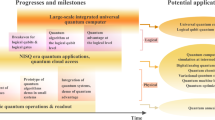Abstract
A systematic approach of designing fault-tolerant systolic architectures is proposed in this paper. In this approach, redundant computations are introduced at the algorithmic level by deriving three versions of a given algorithm. Fault-tolerant systolic array is constructed by merging the corresponding systolic array of the three versions of the algorithm. The merging method attempts to obtain the fault-tolerant systolic array at minimal cost in terms of area and speed. It is based on rescheduling input data, rearranging data flow, and increasing the utilization of the array cells. The resulting design can detect and tolerate all single permanent and temporary faults and the majority of the multiple fault patterns with high probability.
Similar content being viewed by others
References
H.T. Kung, “Why Systolic Architectures?”IEEE Computer, Vol. 15, pp. 37–46, 1982.
J.-M. Delosme and I.C.F. Ispen, “Efficient systolic arrays for the solution of Toeplitz systems: An illustration of a methodology for the construction of systolic architectures in VLSI,”International Workshop on Systolic Arrays, University of Oxford, p. F2, July, 1986. Also inSystolic Arrays, W. Moore, A. McCabe, and R. Urquhart (Eds.), Bristol-Hilger, pp. 27–46, 1987.
A.L. DeCegama, “The Technology of Parallel Processing”Parallel Processing Architectures and VLSI Hardware, Vol. I, Prentice Hall, Englewood Cliffs, New Jersey, 1989.
S.Y. Kung,VLSI Array Processors, Prentice-Hall, 1988.
H.T. Kung and M.S. Lam, “Fault-Tolerance and Two Level Pipelining in VLSI Systolic Arrays,”MIT Conference on Advanced Research in VLSI, pp. 74–83, Jan. 1984.
J.-H. Kim and S.M. Reddy, “On the Design of Fault-Tolerant Two-Dimensional Systolic Arrays for Yield Enhancement,”IEEE Trans. Comput., Vol. 38, pp. 515–525, 1989.
F.T. Leighton and C.E. Leiserson, “Wafer-Scale Integration of Systolic Arrays,”IEEE Trans. Computers, Vol. C-34, pp. 448–461, 1985.
P.J. Varman and I.V. Ramakrishnan, “Optimal matrix multiplication on fault-tolerant VLSI array,”IEEE Trans. Comput., Vol. 38, pp. 278–283, 1989.
V.K. Prasanna Kumar and Y.-C. Tsai, “On mapping Algorithm to Linear and Fault-Tolerant Systolic Arrays,”IEEE Trans. Comput., Vol. 38, pp. 470–480, 1989.
J-H Kim and S.M. Reddy, “A Fault-Tolerant Systolic Array Design using TMR Method,”1985 ICCD, pp. 769–773.
J.V. Neuman, “Probabilistic Logics and Synthesis of Reliable Organisms from Unreliable Components,”Automata Studies, No. 34, pp. 43–99, Princeton, NJ: Princeton University Press.
R.J. Cosentino, “Fault Tolerance in a Systolic Residue Arithmetic Processor Array,”IEEE Trans. on Comput., Vol. 37, pp. 886–890, 1988.
S.-W. Chan and C.-L. Wey, “The Design of Concurrent Error Diagnosable Systolic Arrays for Band Matrix Multiplication,”Proc. IEEE Trans. on Computer-Aided Design, Vol. 7, pp. 21–37, 1988.
R.J. Cosentino, “Concurrent Error Correction in Systolic Architectures,”Proc. IEEE Trans. on Computer-Aided Design, Vol. 7, pp. 117–125, 1988.
E.S. Manolakos, “Transient Fault Recovery Techniques for the VLSI Processor Arrays,” Ph.D. Thesis, University of Southern California, May 1989.
K.-H. Huang and J.A. Abraham, “Low Cost Schemes for Fault Tolerance in Matrix Operations with Processor Arrays,”Proc. 9th Symp. on Computer Architecture, pp. 330–337, May 1982.
K.-H. Huang and J.A. Abraham, “Fault-Tolerant Algorithms and their Application to Solving Laplace Equations,”IEEE Int'l Conf. Parallel Processing, pp. 117–122, Aug. 1984.
K.-H. Huang and J.A. Abraham, “Algorithm-Based Fault Tolerance for Matrix Operations,”IEEE Trans. on Comput., Vol. C-33, pp. 518–528, 1984.
J.-Y. Jou and J.A. Abraham, “Fault-Tolerant Matrix Arithmetic and Signal Processing on Highly Concurrent Computing Structures,”Proceedings of the IEEE, Vol. 74, pp. 732–741, 1986.
J.A. Abraham, P. Banerjee, C.-Y. Chen, W.K. Fuchs, S.-Y. Kuo, and N. Reddy, “Fault-Tolerance techniques for systolic arrays,”IEEE Computer, pp. 65–74, 1987.
H. Lev-Ari and B. Friedlander, “On the Systematic Design of Fault-Tolerant Processor Arrays with Application to Digital Filtering,”1988 VLSI Signal Processing III, pp. 483–494, 1988.
C.J. Anfinson and F.T. Luk, “A Linear Algebraic Model of Algorithm-Based Fault-Tolerance,”IEEE Trans. Comput., Vol. 37, pp. 1599–1604, 1988.
D.L. Boley and F.T. Luk, “A Well Conditioned Checksum Scheme for Algorithmic Fault-Tolerance,”Integration, The VLSI Journal, Vol.12, pp. 21–32, 1991.
W. Shang and J.A.B. Fortes, “On Time Mapping of Uniform Dependence Algorithms into Lower Dimensional Processor Arrays,”IEEE Trans. on Parallel Distributed Syst., Vol. 3, pp. 350–363, 1992.
P. Cappello, “A Processor-Time-Minimal Systolic Array for Cubical Mesh Algorithms,”IEEE Trans. on Parallel and Distributed Syst., Vol. 3, pp. 4–13, 1992.
J.-P. Sheu and C.-Y. Chang, “Synthesizing Nested Loop Algorithms Using Nonlinear Transformation Method,”IEEE Trans. on Parallel Distributed Syst., Vol. 2, pp. 304–317, 1991.
D.I. Moldovan and J.A.B. Fortes, “Partitioning and Mapping Algorithms into Fixed Size Systolic Arrays,”IEEE Trans. Comput., Vol. C-35, pp. 1–12, 1986.
W.L. Miranker and A. Winkler, “Spacetime Representations of Computational Structures,”Journal of Computing, Vol. 32, pp. 93–114, 1984.
M.O. Esonu, S. Hariri, and A.J. Al-Khalili, “A Systematic Approach for Mapping Algorithms into Optimal Systolic Architectures,”IEEE Symp. on Parallel and Distributed Processing, Dallas Texas, Dec. 9–13, 1990, pp. 166–173.
M.O. Esonu, A.J. Al-Khalili, S. Hariri, and D. Al-Khalili, “Systolic Arrays: How to Choose Them,”IEE Proceedings-E, Computers and Digital Techniques, Vol. 139, pp. 179–188, 1992.
H.F. Li, C.N. Zhang, and R. Jayakumar, “Latency of Computational Data Flow and Concurrent Error Detection in Systolic Arrays,”CCVLSI '89, pp. 251–258, 1989.
M.O. Esonu, A.J. Al-Khalili, and S. Hariri, “Area Efficient Architectures for Concurrent Error Detection in Systolic Arrays,”IEEE Int'l Conf. on Parallel Processing (ICPP '91), St. Charles, IL., 1991, pp. 1484–1491.
M.O. Esonu, A.J. Al-Khalili, and S. Hariri, “Fault-Tolerant Computing Structures for Systolic Arrays,”Int'l Symp. on Mini and Micro-computers (ISMM), Pittsburgh, Oct. 1992, pp. 40–45.
L. Chen and A. Avizienis, “N-version Programming: A Faulttolerant Approach to Reliability of Software Operation,”Proc. Int. Symp. Fault-tolerant Computing, pp. 3–9, 1978.
H. Hecht, “Fault-tolerant software,”IEEE Trans. Reliability, pp. 227–232, Aug. 1979.
Author information
Authors and Affiliations
Rights and permissions
About this article
Cite this article
Esonu, M.O., Al-Khalili, A.J., Hariri, S. et al. Design techniques for fault-tolerant systolic arrays. Journal of VLSI Signal Processing 11, 151–168 (1995). https://doi.org/10.1007/BF02106828
Received:
Revised:
Published:
Issue Date:
DOI: https://doi.org/10.1007/BF02106828




